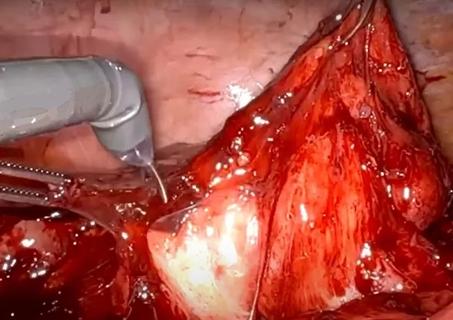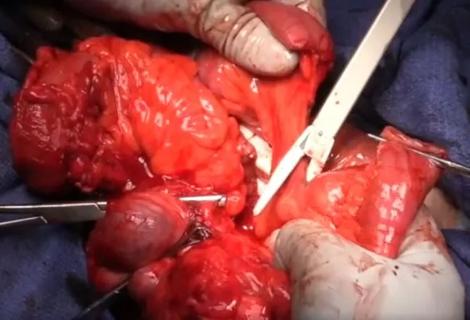Advertisement
A 68-year-old man with a history of CABG complicated by sternal infection requiring omental and pectoralis flaps presented with a recurrent subxiphoid hernia. Even after three previous repairs with both AlloDerm™ and implanted expanded polytetrafluoroethylene mesh, the sternal defect measured 25 cm wide by 30 cm long. Intestinal contents were herniating from beneath the subxiphoid region and lying on top of the sternum.
Advertisement
Cleveland Clinic is a non-profit academic medical center. Advertising on our site helps support our mission. We do not endorse non-Cleveland Clinic products or services. Policy
In this brief intraoperative video, watch surgeon Michael J. Rosen, MD, Director of the Comprehensive Hernia Center at Cleveland Clinic, and his team perform the complex reconstruction.
Dr. Rosen takes special care not to inadvertently enter the hernia sac and injury anything underlying. The team then opens the hernia sac to reveal that both large and small intestine have herniated. The team carefully inspects the bowel to ensure no inadvertent serosal tears are left unrepaired. The surgeons expose the abdominal wall and create a retromuscular space by sizing the posterior rectus sheath approximately half a centimeter from the linea alba. They then carry the incision inferiorly to the pubis taking great care to avoid the inferior epigastric vessels. The lateral dissection is carried out to the linea semilunaris, and further dissection is performed superiorly to the point of the level of the costal margin, a landmark for the beginning of the transversus abdominis release.
Just anterior to the first palpable rib, the posterior lamella of the internal oblique is incised to reveal the transversus abdominis muscle underneath. The surgeons identify the neurovascular bundles and use careful traction and countertraction to discern the planes of the muscles. The posterior lamella of the internal oblique is again incised.
Due to the superior extent of this hernia defect and the need for mesh overlap, Dr. Rosen creates a deep subxiphoid pocket by separating the peritoneum off the overlying diaphragm. He creates a lateral pocket using good traction-countertraction technique. Watch the video to discover what happens once the transversus abdominis has been fully released.
Advertisement
Advertisement

Technique is useful in patients with diffuse stricturing Crohn’s jejunoileitis

Lifesaving procedure, continued pregnancy and healthy delivery highlight program’s advancement

Robot-assisted technique provides an alternative to open surgery in a complex case

Cleveland Clinic team blends extended mesenteric excision and Kono-S anastomosis

Continued pregnancy and delivery are only the second successful outcome worldwide

FETO and twin-twin transfusion syndrome treatments are next

New procedure eliminates volvulus risk

Measuring outcomes becomes more granular with surgeon-entered data